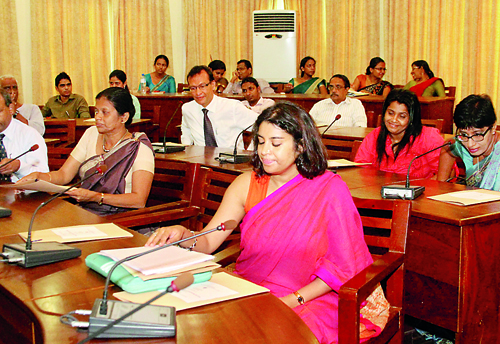News
Dharmapala’s mission was to re-establish Buddhism in its birthplace: Prof. Dissanayake
View(s):The symposium to commemorate the 150th birth anniversary of Anagarika Dharmapala, ‘Anagarika Dharmapala and India-Sri Lanka Relations’ was held at the Senate Hall of the University of Colombo on Wednesday(24).
Indian High Commissioner Y.K.Sinha was the chief guest at the symposium organised by the Centre for Contemporary Indian Studies (CCIS) of the University.
Addressing the gathering, that included a number of university academics, the High Commissioner said that Anagarika Dharmapala was not only a great social reformer in Sri Lanka but also in India.

A section of the audience
He said Anagarika Dharmapala worked hard to restore the pristine glory of the Mahabodhi Temple in Bodhgaya (Buddha Gaya) and that one can freely visit these shrines and temples today.
“While Emperor Asoka encouraged the spread of Buddhism, Dharmapala played a major role in spreading Buddhism in Asia, Europe and North America,” he said.
High Commissioner Sinha said that the first classes of Buddhist learning began close to Nalanda University in India, earlier this month.
“A new Nalanda University on Buddhist learning is being built and the glory of temples of learning such as Thakshila and Wickremashila are being revived,” he said.
Emeritus Prof. J.B.Dissanayake, who delivered the keynote address said the speech made by Anagarika Dharmapala at the World Parliament of Religions in Chicago in 1893, was delivered with such eloquence and elegance that it had an impact on a non-Buddhist audience.
“Prof. Burrows who chaired the sessions is reported to have said that Dharmapala looked ‘like Christ in a saffron robe’,” he said.
Prof. Dissanayake said that Anagarika Dharmapala’s mission was to reestablish Buddhism in the place of its birth.
“Over many years, he had to fight a hard battle in a foreign land, and was able to gain a foothold for the Buddhists there. In this struggle, there were many Indian Buddhists who helped him. Today, Buddha Gaya has become a UNESCO heritage site and the Mahabodhi Temple there caters to the needs of the Sinhalese Buddhist pilgrims,”he said.
Prof. Dissanayake said Dharmapala’s wish was to be born at least twenty five times more to reestablish the Buddha Sasana by taking the message of the Buddha to the world.
The academic session was graced by several academics including Dr. Gitanjali Surendran, Associate Professor Jindal Global University, Delhi, Emeritus Prof. K.N.O.Dharmadasa, Editor-in-Chief of the Sinhala Encyclopedia, Dr.K.D.G. Wimalaratne, Former Director, Department of National Archives, and Prof.Asanga Tilakaratne of the Pali and Buddhist Studies Unit of the Colombo University.
Professor Gitanjali Surendran discussed the topic ‘Anagarika Dharmapala in India: A Buddhist Cosmopolitan?’
“For Dharmapala, a revived Buddhism and a united Buddhist world could solve all of Asia’s manifold problems and restore her to what he saw was her rightful place as the centre of civilisation once more,” she said.
She described Dharmapala’s life and activity – his many years spent in India trying to revive Buddhism, creating a Buddhist pilgrimage map and an Asian Buddhist identity.
The Dharmapala-led Buddhist revival movement aimed to provide a foundation for a transnational, cosmopolitan community of Buddhists based on a conception of Indo-Aryan oneness that often appeared contrary to his own activities in Ceylon where he was accused of promoting a jingoistic Sinhala exclusivism”
Professor Tilakaratne said that Anagarika Dharmapala outlined a broad progamme for the propagation of Buddhism in the West and it included working with all forms of Buddhism in the Buddhist world.
He said that this testified to his global vision of Buddhism cutting across traditional boundaries, physical as well as ideological.

